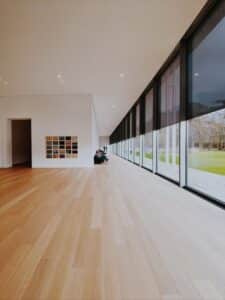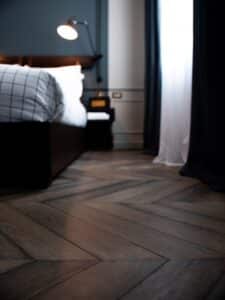
Homeowners tend to invest in long-lasting and premium quality hardwood that will survive through numerous scratches and water spills while keeping its rich and vibrant colour. General wear and tear is inevitable, and even the timber floor that is advertised for the longest durability does not stand a chance against time.
Luckily, there is a way to maintain your timber floor in good condition and extend its lifespan. To do this, you need to apply a floor finish that protects the top level from degrading over time.
Finding the best floor finish can be daunting; that’s why we have prepared for you the list of the most popular hardwood floor finishes.
Keep reading to learn the differences among them in order to decide which protective coating will work the best for you.
What Is a Wood Floor Finish and Why Do You Need It?

Timber floor finishes are necessary if you want to keep your flooring in good condition and protect it from scratches and cracks. Even weather changes can cause your floor to expand or shrink if it is exposed to high humidity and changes in temperature. Although a brand new coat won’t entirely stop it from changing its shape, it will significantly reduce the long-term damage.
You may notice that some parts of your timber floor look perfect while other areas have lost their natural beauty. This is common for rooms where foot traffic prevails, especially in the kitchen and living room. Pets or furniture can leave scratches on the timber surface, and consequently, it will absorb any liquid that drops into those vulnerable spots.
Hardwood floor finishes work as screen protectors for smartphones. They don’t entirely deflect damage when you drop your cell phone but prevent it from cracking and scratching the screen. Hardwood floors are easy to maintain with the right finish, and some even enhance the colour.
Types of Finishes to Protect Your Vinyl, Hybrid, or Timber Floors
Hardwood floor finishes vary in their ingredients and properties, some can be non-toxic while others have to be applied with a respirator. The toxicity level is determined by VOCs or Volatile Organic Compounds. VOCs are included in many household items, including some timber floor finishes.
It is highly important to research the level of VOCs before applying the coating without professional assistance. Long exposure may lead to many health complications.
Polyurethane Finishes
Polyurethane protective coating is a popular choice of many homeowners for valid reasons. It is durable, resistant, and affordable. It comes in oil-based and water-based types – both are great to use on timber floors.
Water-Based Polyurethane
Water-based polyurethane has milky consistency but it dries quickly and also has a lower VOC level than an oil-based finish. You shouldn’t wait too long before applying the next coating; otherwise, you will leave lap marks.
It is also important to note that the finish resists yellowing over time and stays clear, and you will have a beautiful, smooth, and glossy timber floor.
Although water-resistant, it is not advised to ignore water spills. It is very effortless to clean the timber floor after applying this finish – damp-mopping is sufficient.
- Advantages:
- Non-yellowing
- Dries quickly
- Low VOCs
- Eco-friendly
- Easy to apply
- Disadvantages:
- Scratches are more visible
- More expensive than oil-based timber floor finish
Oil-Based Polyurethane
Oil-based polyurethane is extremely durable and is relatively easy to apply without professional help. It takes approximately 9 hours to fully dry, and you will have to put on a respirator not to breathe in the odour, and leave the house until the smell dissipates. Also, you won’t be able to walk on it during the drying period.
Oil-based polyurethane is ideal for high foot traffic areas. You can notice a slight amber shade added to your flooring with age. So, if you want to keep a bright milky colour of your timber floors, instead use a water-based finish.
- Advantages:
- Very durable
- Inexpensive
- Easy to apply
- Disadvantages:
- May turn to yellow colour over time
- Dries very slow
- High VOCs
Moisture-Cured Urethane
Moisture-cured urethane is a more efficient floor finish than oil- or water-based polyurethane. It dries faster than oil-based and it is also extremely durable. It is perfect for high traffic areas; however, it requires a professional to correctly apply the finish to avoid lap marks.
Since it is highly toxic, the homeowners and pets should vacate the house and ventilate it properly for up to two weeks. The refinish can be done every 2 or 3 years.
- Advantages:
- Very durable
- Dries fast
- Disadvantages:
- High level of VOCs
- Strong lasting odour
- Professional application only
Shellac
Shellac is one of those floor finishes that is easy to apply for a DIY-enthusiast as it has a low level of VOC. It is not durable as modern products but sells at an affordable price.
Shellac hardwood floor finish is mostly used in old houses with antique floors built in the 20th century. Those buildings keep using shellac because this floor finish is not compatible with other products, except for wax.
- Advantages:
- Easy to apply
- Low level of VOCs
- Disadvantages:
- Not durable enough
- Refinish should be done regularly
- Cannot be refinished with anything other than shellac or wax
Wax Finishes
Wax penetrates the wood and darkens it. If you want to maintain the natural colour, make sure to apply shellac as a base coat. Wax is applied by hand so any DIYer can do that; however, it is a long and tiring process since you will be covering small parts of your flooring.
It is a natural product so the VOC content is low. It penetrates into the wood so remember to remove water drops to avoid leaving a stain.
- Advantages:
- Easy application
- Low VOC level
- Mild odour
- Disadvantages:
- Susceptible to stains
- Should be refinished regularly
- To refinish, the ages coating should be fully removed
Penetrating Oil Sealant
Oil sealants penetrate the wood and protect it from spills, stains, and scratches, and give it a nice deep wood colour.
It contains low VOCs because its main ingredient is tung oil. It is durable but doesn’t compete with oil-based polyurethane. It takes approximately two days to fully dry the first layer of floor finish in order to apply the next one.
- Advantages:
- Easy to apply
- Non-toxic
- Eco-friendly
- Disadvantages:
- Long drying time
Other Finishes for Timber Floor
Hardwax Oil
Hardwax oil finish contains natural oils like linseed oil, soy oil, tung oil and hard waxes. It is applied by hand and it gives the natural look to your floors. It is also easy to clean, and it is highly water-resistant.
- Advantages:
- Non-toxic
- Easy to apply
- Highly water- and stain-resistant
- Disadvantages:
- Not as long-lasting as polyurethane
- New coatings should be applied regularly
Acid-Cured (Swedish) Finish
The acid-cured Swedish hardwood floor finish is the hardest and most enduring material to apply to your flooring. Since it is so powerful, it also has a strong odour and high VOC content.
After it is applied, homeowners should properly ventilate the house and vacate it for a few days. It also takes two months to fully cure; however, people can walk on it after three days. Although the furniture, including carpets, should be moved elsewhere.
- Advantages:
- Extremely long-lasting
- Disadvantages:
- Extremely high level of VOCs
- Should only be applied professionally
- Expensive
- Highly flammable
Aluminium Oxide
Another long-lasting and hardest floor finish is aluminium oxide. It protects floors from scratches and is highly resistant to water damage. It is not applied by homeowners but only on prefinished planks.
Since it is done by professionals before you install the flooring, it is extremely hard to remove by yourself. Although the aluminium oxide can last two decades, when the time comes to refinish the floor, you will definitely need professional help.
- Advantages:
- Long-lasting
- Water-resistant
- Doesn’t change colour with age
- Requires low maintenance
- Disadvantages:
- Only done on prefinished planks
- Hard to remove
What Is the Most Durable Hardwood Floor Finish?

Among all hardwood floor finishes the most long-lasting ones are acid-cured and moisture-cured; however, both have their disadvantages. Acid-cured products are expensive and hard to remove to apply a new finish while moisture-cured ones require professional help. Both are highly toxic with a strong odour and require you to vacate your house for a few days. Another most durable hardwood floor finish is aluminium oxide but it can only be applied on prefinished planks.
If you want to be able to maintain floors once in a couple of years and easily apply the finish yourself, perhaps polyurethane finishes will be a better option. Either oil- or water-based will work fine with most floors. They are affordable and keep the colour fresh and natural.
Conclusion
Choosing the right finish is daunting; however, this list will help you compare the pros and cons of every product. You should decide whether you plan to apply the finish by yourself or hire a professional and decide how often you can afford to refinish your floors.
If you want to do it yourself, consider the amount of time it is going to take you to finish all the coatings. Another factor is whether you can vacate the home for a few days to apply a finish with a high level of VOCs or whether you prefer an eco-friendly product.
Knowing your criteria will help you determine which floor finish is best for your needs and budget.
